#extant projects: 2019
Explore tagged Tumblr posts
Text




On October 3rd, Elric asked me what day it was.
I said, ‘How dare you to talk to me, you coward.’
Major General Olivier Mira Armstrong
Traditionally tailored uniform, 2019
Japanese twill, canvas, grosgrain, leather, gilt braid
#project: major general Olivier Mira armstrong#media: fullmetal alchemist#fma#fullmetal alchemist#Olivier Armstrong#fullmetal alchemist day#extant projects: 2019#tailoring#historical costume#historical sewing#cosplay#poetry in costume#I’m still so sad about my wig in this shoot - it took me a while to really nail the armstrong curl plus this was the hottest day that year#and I moved a bunch of furniture around after I was bewigged so that really messed things up. oh well!#at least I nailed it for competition#tho I have exactly one selfie to prove that
453 notes
·
View notes
Text
Here, have the top ten video game fandoms on The Archive of Our Own every year since the archive started
These tables show the current number of extant works (including archive locked works) on the AO3 created before Jan 1st of each year.
This is just the top fandom lists from a much larger project. For graphs, full details on methodology, a separate section on the Dragon Age tags, these lists in text rather than screenshot format, and more, see the full work here here

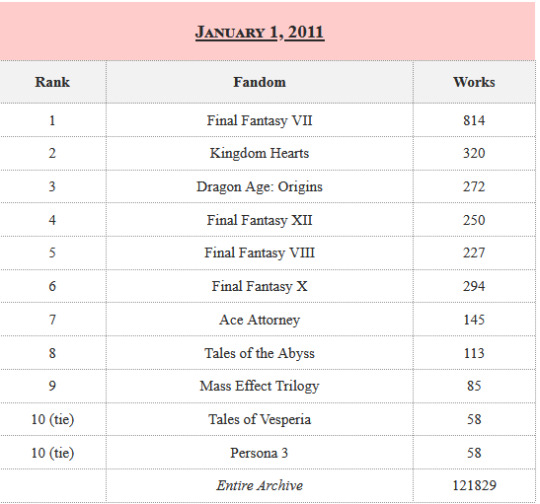
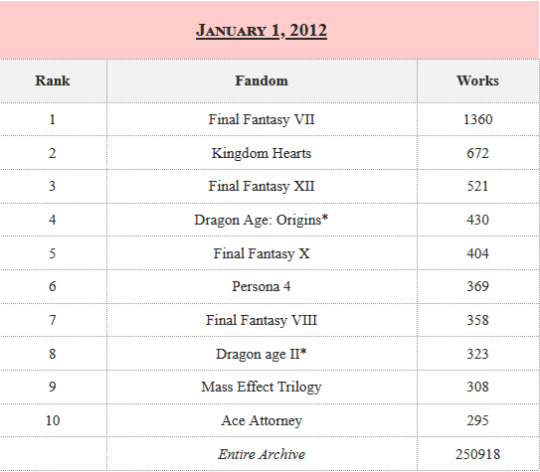

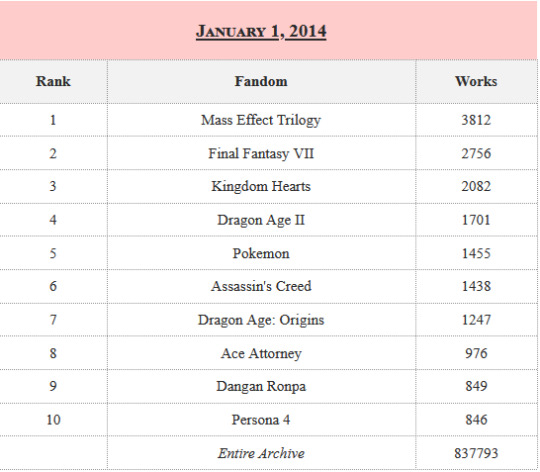

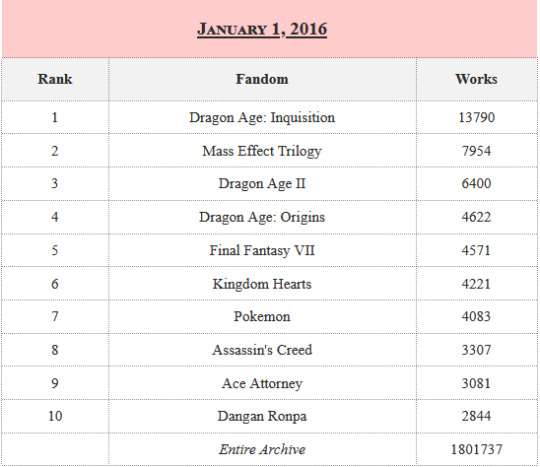
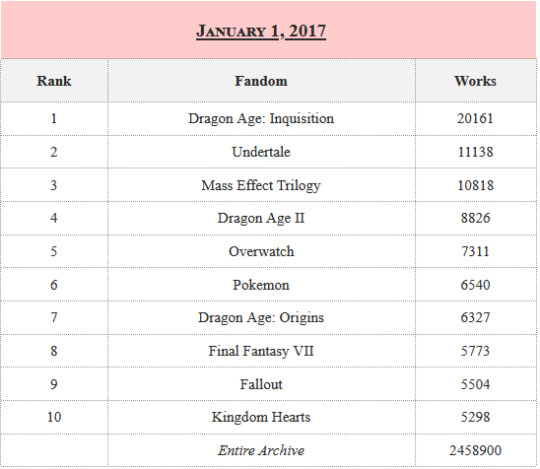
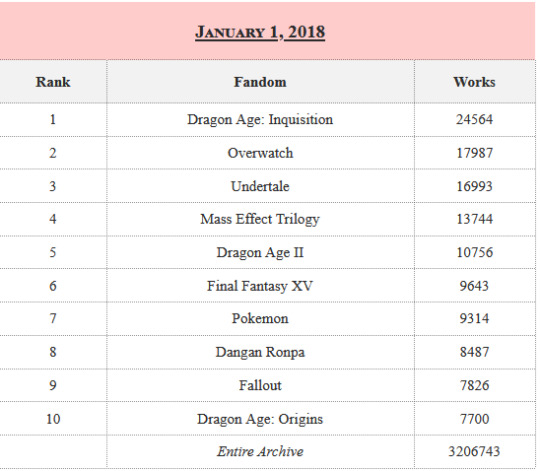
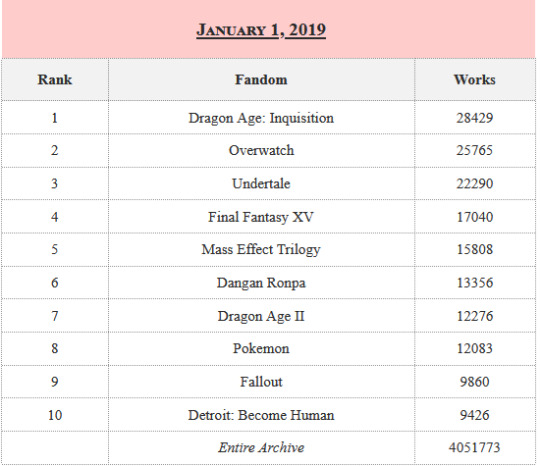


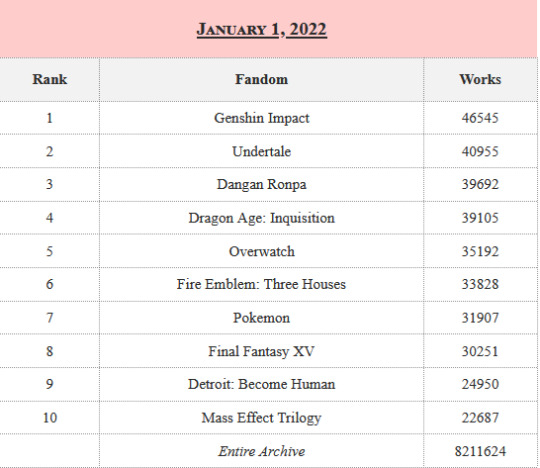


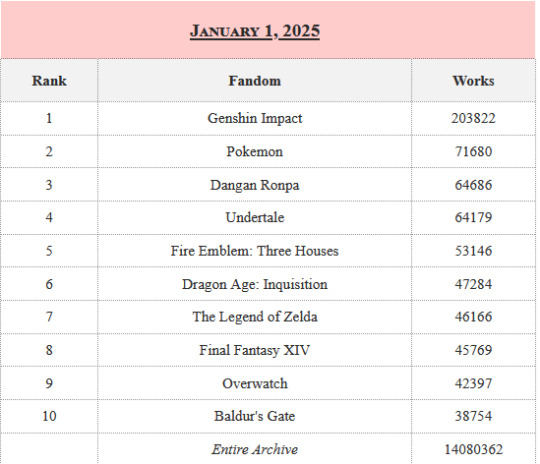
https://archiveofourown.org/works/62226781?view_full_work=true
EDIT: First error spotted! Legend of Zelda was missed in the 2024 list, I've updated the screenshot and it now correctly appears in ninth place
EDIT 2: Somehow the screenshots for 2019 and 2020 were missing? I'm blaming Tumblr, they're here now.
#fandom statistics#fandoms stats#AO3#archive of our own#fandom history#fandom meta#video game fandoms#fandom research#top fandoms
1K notes
·
View notes
Text
“That’s not realistic, that’s utopian!” [...] is often used as a bludgeon to manage proposals and people and actions that have gone too far out of bounds, so to speak. [...] There were good reasons to distrust and even dismiss the term utopian, although in my opinion, the main problem was not idealism and futurism, but rather the term’s deeply racialized historiography [...]. Not to put too fine a point on it, the extant meaning of the term treated the [...] colonialism that founded the so-called New World as a successful utopian enterprise while absenting entirely what Peter Linebaugh and Marcus Rediker call the “many-headed hydra” of the seventeenth-century “revolutionary Atlantic,” those slaves, maids, prisoners, pirates, sailors, heretics, indigenous peoples, commoners, etc. who challenged the making of the modern world capitalist system. Why hold onto a term in which its best practitioners are excluded?
There was a another kind of utopianism entailed by slaves running away, marronage, piracy, heresy, vagabondage, soldier desertion, and other illegible or discredited forms of escape, resistance, opposition and alternative ways of life that continued, of course, to challenge the modern racial capitalist system over time. This other utopianism lends to the term utopian a very different meaning, one rooted much more in the past and the present, and a very different notion of politics, one rooted in ongoing social struggles, in various forms of non-participation [...].
---
Yet or also, there is widespread, daily, active open political opposition to all this at the scale at which people can contest it: protecting this group of migrants from arrest, confinement and deportation; organizing this strike among teachers in this city; defending this territory from oil drilling; filing law suits against a police department and so on; gathering in public to swear, shout, shake fists, confront the inevitably helmeted riot police. There is also widespread, daily, active, infrapolitical and even secret political opposition, which needs and wants to remain hidden. And there are also so many people, more and more in the western wealthy countries, looking for ways to think and live on different – better terms – and doing it in small ways, whether in local collectives, or in extended family units, with illegal housing and electricity, alternative currencies, in cities and on old tribal lands.
---
What will happen we don’t know, of course. But more and more as people cannot participate in the existing economic and governing systems, they must find another way. [...] Solidarity, assistance, fellowship will be needed. [...] Being in-difference is [...] a mindset for living on better terms than we’re offered, for living as if you had the necessity and the freedom to do so, for living in the acknowledgement that, despite the overwhelming power of all the systems of domination which are trying to kill us, they never quite become us. [...]
We have to build ourselves – it’s not going to be given to us -– the infrastructure for life without or despite capitalism, a life in which we are not enclosed by values and modes of being together based on money and exchange values, status hierarchies, violence and force, alienation, racialization, and discipline to externally imposed standards. That job is enormous, complex, difficult [...]. But it must start with each individual, in common with others, learning to become “unavailable for servitude [...],” to use [...] Toni Cade Bambara’s words. This is the heart of the abolitionist imaginary, [...] so that the struggle to transform the world takes place immanently today now [...].
---
Words of Avery F. Gordon. As interviewed by Krystian Woznicki. Published as: Avery F. Gordon and Krystian Woznicki. “Unshrinking the World: An interview with Avery Gordon on her recent book The Hawthorn Archive: Letters from the Utopian Margins.” transversal texts. February 2019. This interview was conducted as part of Berliner Gazette’s MORE WORLD project. [Bold emphasis and some paragraph breaks/contractions added by me.]
2 notes
·
View notes
Text
Kickstarter: It mostly delivers
Kickstarter was greeted with great enthusiasm especially by the indie and 3rd party publisher community initially. Suddenly you had a way to collect money to make exciting things.
Then a good number of projects actually failed to deliver anything. From my point of view, back in the day scamming wasn't the cause. Mostly it was just that many people new to publishing overestimated their own capabilities or their ability to deliver. In some cases, especially when it came to third party publishers, the licensor stepped in to protect the brand.
All was not well, but from my point of view, most still was.
Still, you could hit a few projects, collecting lots of money, which would then never deliver. Or deliver very little and then go silent. Enticing projects as such, promising to deliver lots of goodies on long-dead game lines people had once fallen in love with. Hard to resist!

I came into KS a bit after the initial rush, and I must say, besides pumping a lot of my money into crowdfunding, looking at the early lessons of others (as published on social media at the time, especially the now-defunct RPG discussion heaven Google+) and being also lucky, helped.
Some statistics, anecdotical, of course
I started getting lured into Kickstarter around fall 2012. In the time up until now I have backed 332 projects, mostly indies and third party products, but also some quite big publisher preorders.
Out of these 332 projects (only counting those that funded), I identified 11 problem projects that failed to deliver so far and some of them will likely not until the end of time. So, so far up to 96.7% of projects I would deem as delivered or sure to deliver (the 332 contain some recent pledges).
Let's look at those duds:
There's 3 'zine projects. So basically small, indie products that cost almost nothing. Most of those projects still delivered, but these three stopped updating up to four years ago. (Still amazed how mad people can get over an amount of 3-4$ in the comment sections of those failed projects.)
There are two full-priced (double-digit pledge) indie projects that petered out and didn't deliver.
Another cheap indie by a person I've known and followed for a while had a rewrite mid-project and has been stuck in art without updates since last year. Not promising but might revive.
Another project is horribly, horribly late (4 years by now) but I like this creator's output and the updates are still coming and they just finished another project, so this one is in all likelihood not a dud. Just a test of patience.
I really don't want to call out indies, though. But here's a few I'd like to name:
"City State of the Invincible Overlord": Judges Guild products were originally big campaign settings from the really early time of gaming. Their reissue projects have seen massive failures to deliver, and so has this one. Scandals surrounded the project. Partially extant since 2014. IIRC, even an indie publisher stepped in to partially deliver to protect his own brand.
"Distant Realms, a guide to the land of Leviathan": By now in its 9th year of being overdue, this project is notorious for its many updates of why the dog ate their homework, how the project was handed over from people that got money to people who do it out of a sense of obligation to people who basically just seem to write updates when they should give a damn refund. If you want an education in how to write bad excuses for not doing one's job, look to this project's updates. The chutzpah of some updates is quite impressive. And this publisher had many projects. They were also rude and unhelpful when contacted, even before this mess.

Delta Green hardcovers (two projects): Delivery promised for 2016 and 2019, respectively. I love Delta Green, and they did these campaigns promising lots of hardcovers. This was a "might not come again" thing - at least for the first one. The second one was on me. Now, I'm not overly unhappy with this one in spite of having spent hundreds of dollars on them. Thing is, they're delivering good stuff, beautiful stuff. But. So. Slow. We will get our shiny things, it's been trickling in. But I wonder how many people would have backed if they'd known their rewards would take almost ten years to deliver. I think that's worth calling out.
What to look out for
First of all, as Kickstarter makes you confirm, deliveries aren't guaranteed. That certainly covers their liability but helps us backers very little.
In general, look for these signs in KS projects:
Good: The project text has been already written as a final draft (not covering stretch goals). Look for projects that basically want to fund art and print.
Bad: Projects that are not written yet often overrun their time table terribly. Writing is very unpredictable. I had projects where I got updates for years about their writing progress, sometimes with elaborate tables and progress bars to prove they're still going. Chances are, you won't care anymore when they deliver.
Good: A known publisher with a good track record of delivering stuff. (There are known publishers that have a sordid record for delivering on their crowdfundings, so better check.)
Bad: An unknown or indie publisher who seeks funding for a whole line of books. They almost always vanish at some point, leaving you with less than you backed, too late, too little.
Good: A small project (one book, zine) with a limited scope. Very likely this publisher has a plan and can keep to it.
Bad: Projects with endless stretch goals. Typically this entices more backers, like a pyramid scheme, but makes project failure or partial delivery very likely. Even if delivered - how likely is it that the book #7 is still of good quality? Notable exception: Modiphiüs! They started really small (I even did some proofreading for them back in the early days), got some big projects funded, and they delivered everything. Talk about bucking the trend!

Bad: Reviving a long-dead (possibly old school) game line as an indie publisher, even if known people from back in the day are involved. This does seem unfair, because some of these have delivered top-notch products, but some really high profile failures cluster here. This includes often offerings of shiny new books for projects from earlier editions of D&D, things people remember fondly even from 3e which has been old enough now to trigger nostalgia in adults with spending money for quite a while.
Good: Zine projects! Yes, some of them will fail, but you get crazy and interesting ideas for a few bucks, so failure won't really hurt much in comparison.
Bad: Never trust a shiny project page with lots of art and stretch goals. Look for other signs this will work out, everything else is smoke and mirrors.
Hard to predict: The project owner is the main or only artist of the project. Some of these projects may turn out fantastic, but these are very likely to get overwhelmed as well (and then not deliver).
Good: The project owner has delivered similar size projects before. They either delivered similar projects through known RPG selling sites, or, if through crowdfunding, they not only delivered similar things but within a reasonable time frame.
Bad: One person projects. Yes, there are some amazing project creators out there who deliver like clockwork. But if it hinges on one person, be prepared for them to fall sick and all the other things that just happen to humans. It's simply riskier, so just be aware of that.
And there you have it. May your crowdfunding luck hold true!
0 notes
Text
Sessão Mutual Films: Nossa própria imagem, um espelho de beleza: Os filmes de Camille Billops e James Hatch [Mutual Films Session: Our Own Image, A Mirror of Beauty: The Films of Camille Billops and James Hatch]
March 11: The link above leads to Portuguese-language information about the 22nd edition of the Mutual Films Session, co-curated and organized by me and Mariana Shellard, whose screenings will take place between March 12th and 31st at the São Paulo-based unit of the Instituto Moreira Salles and on March 23rd and 30th at the newly opened screening room of the Instituto's unit in Poços de Caldas.
The event provides Brazil-based audiences with the country's first-ever retrospective of the films of Camille Billops (1933-2019) and James Hatch (1928-2020), a team of American artists and archivists that made brilliantly self-reflexive documentaries, several of which are focused on members of Billops's family, who come to represent different aspects of African-American life. The films investigate with profundity, wit, and humor an American condition of cracked interiors covered up by smooth surfaces, with the eternal hope of creating a less hypocritical and more open world.
The series's three programs will present newly digitized copies of all six of the films made by Billops and Hatch (who, among other things, founded the Hatch-Billops Collection, currently stored at Emory University and one of the largest extant archives devoted to African-American art and culture). Five of the films have been remastered in 2K, an initiative undertaken by their longtime distributor, the New York-based Third World Newsreel. The sixth - the couple's remarkable early portrait film of one of Billops's cousins called Suzanne, Suzanne - has been restored in 4K by the nonprofit entity IndieCollect.
The filmic works of Billops and Hatch received much positive feedback during the directors' lifetimes, but their reception has experienced a renaissance during the past few years thanks in good part to the availability of these new copies. Among critical texts that have recently been published, a piece by Yasmina Price written in conjunction with a streaming series of the couple's films on The Criterion Channel is particularly full. Contemporary researchers are fortunate to be able to have access to multiple interviews that Billops gave, including a long conversation from 1996 with bell hooks (included in hooks's book Reel to Real: Race, Sex, and Class at the Movies, whose Brazilian edition was published late last year by Editora Elefante) and a 1992 talk with Ameena Meer for BOMB Magazine that we were fortunate to be able to translate into Portuguese for our website.
The series's opening screening in São Paulo on March 12th will include a public post-screening conversation about Billops and Hatch's films with Aline Motta, an important contemporary Brazilian artist whose multidisciplinary works contain points of resonance with the couples' projects. The series is dedicated to the memory of the German filmmaker and activist Renate Sami, and it could also easily be dedicated to the memory of Philip Shellard, a quiet and generous recently deceased cinephile whose accomplishments include being Mariana's father and a figure of unrelenting support.
0 notes
Text
Zoo of the Future
SCIENCE FICTION_Imagine yourself the times, relatively close nearly to us such as alternative reality, when we save populations from the brink of extinction. Yet, the technological industry across Kaucasus or Orient Wild not yet definied most valuable protected areas and indigenous lineages, whose should be protected most and priority. Some of them are threatened and whole are relic of early holocene. Inaniel Uagri-Qehałj phD, which is confirmed russian-spanish hetero with roots from china, we think implicitly, is entrepreneur involved in initiative devoted to Zoo of The future, which is located in Arkem, the small futuristic country-city, the autonomous inland of South Poland. Alternative reality allows us to think this is embarking work called Orczidt Project, which is the most innovate for dreamers and diplomatic consultants. Wanted lineage is on of the job from the initiative gathered extant populations, which are evolutionary distinct or being on the edge of existence and so on. It is heroes titanic work for generations and large amount of lineages and populations from the continents of Old Earth and other spaces and wild places worldwide.
refs: europe cryptozoology vs science fiction and fake science. LOST TV drama episode of growth for Arkem and Uaquavai. The future is Wild. volume one. creative commons quatlwork_12 of 2019.
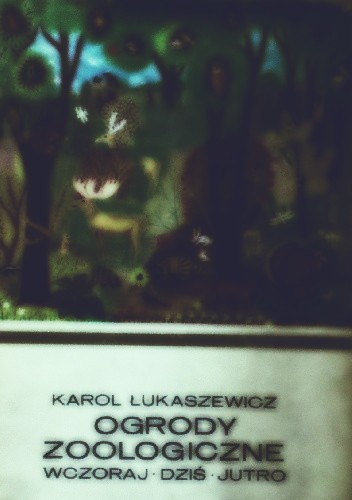
<for more visit< < Chutzpah … a drawing for ‘Zootopia’ in Jutland, Denmark. Photograph: Big < A proposal for St Petersburg … a gatherings of islands surrounded by water and dotted with biospheres. Photograph: Artefactory ZSP
link: https://quatlnotesdraw04.creatorlink.net/Zoo-of-the-Future
1 note
·
View note
Text
In my 376th review, I take a look at The Nevers 1x01 "Pilot"
Spoilers Below
Before we can even talk about The Nevers, we have to talk about the massive elephant in the room, Joss Whedon. This was going to be his next big project, but left during post-production, citing at the time, difficulties with the process during a global pandemic. In the time since that news broke, a massive swath of allegation of abuse have come out against Joss, and has in turn, cast a long shadow over this series, as he still has major credit on the majority of episodes. The actions that he has done are horrific and he does not deserve any praise for his work at this point, as no art is worth the pain that Joss Whedon has created while creating it. Knowing what we know now, the niggling feeling that thing that have affected his other productions in such horrific ways have thus also affected this production are hard to dissuade.
This knowledge in turn, creates an interesting viewing experience, as this would not be a bad product if the sword hanging over it weren’t there. The opening episode of The Nevers is very much a textbook example of why context matters, and in turn, affects how people view a product. Let me get my little bit of unequivocal praise out of the way though, lead actresses Laura Donnelly (from Outlander and Britannia) as Amalia True and Ann Skelly (from Kissing Candice and Red Rock) as Penance Adair pulls so much of this show on their back. The only reason that this isn’t a complete train wreck is this pair.
Beyond that, it’s all muddled praise at best, as much of what I might call out as good is tempered by the larger situation surrounding this show that I talked about above. We get the writing, and specifically in regard to Maladie (played by Amy Manson from Once Upon a Time and The White Princess) which are kind of sketchy, being stock archetypes of the violent mentally ill person. The early parts of this episode draw a direct tie between Maladie and the likes of Jack the Ripper. The there is Hugo Swan (played by James Norton from the 2019 version of Little Women and the 2017 production of Flatliners) a character who is presented as bisexual from his opening scene, and also is at least being hinted at towards being a villain, though his status is a lot more fuzzy then Maladie’s at the current moment. For a show that is riffing off the X-men brand of people with powers allegories where the persecution of these characters that are othered from the society, but the show focuses on thus creating investment, the hope is that we, the audience, in turn realize the persecution of people that the society we live in have othered. In the classic case of X-men, this is LGBT+ people, and I think in this case, they are talking about the mentally ill, or maybe just generally chronically ill, as with how much this opening episode talk about the Touched, their in universe term for people with powers, as a medical condition. This whole endeavor becomes counter productive as they have characters who are already parts of those societies that they could be using this as an allegory for, and they have already to some extant villainized both of them.
Then we have the ending, which explains a whole lot about what they are trying to do with this universe, but ends up making it feels so much lamer than the set up they had throughout the first episode. While it doesn’t necessarily break the episode as whole, it certainly makes it even more challenging to even try to recommend this episode, even without the controversy hanging over it’s head.
Overall, this is a messy episode at the best of times, and while the two leads do a lot of work and make this not just a watchable, but somewhat enjoyable experience. That is, in spite of all the major issues this show has both on the production side and in the larger writing. 5/10
4 notes
·
View notes
Note
Hello! I love your blog and I’ve decided to finally try to start making historical clothing! I’ve got a degree in textiles and made modern clothing so I’ve got a fair bit of experience with sewing and patterns etc. But I’ve never drafted my own properly, which seems to be the way to go for decent clothing of the era I like (mid 18thc ish). I want to make some breeches and I’ve seen you’ve made quite a few! I would love any resources you have for breeches, advice etc. please!
Wonderful! I’m always happy to see more people starting historical sewing!! I have a big post of 18th century menswear resources, and it mentions a few places to find pattern diagrams. LACMA Pattern Project and The Cut of Men’s Clothes are free, but Costume Close Up has the most construction information. My most thorough post on breeches construction so far is the one about my 1730′s ones. I haven’t got a good post on later breeches from start to finish (and due to camera troubles I didn’t photograph the earlier steps of the pair I’m making now) but aside from the front closure the construction is pretty much the same. The 1730′s ones close with a button fly, but I have a tutorial on how to machine sew fall fronts.
In the middle of the 18th century they changed from fly fronts to fall fronts (because waistcoats gradually got shorter and the fall front made the visible bit smoother and nicer looking) so if you’re doing mid 18th century it could go either way. Here’s my pinterest board of extant breeches if that’s any help. Some of the source links are no good but some have good detail shots.
When I scale up/draft patterns I just sort of measure myself and draw up the patterns according to the measurements, which I should perhaps try filming sometime. I trace the pattern piece diagrams onto a small sheet of paper, I stand in front of a mirror and measure where those pattern pieces would be on me and how big various parts of them would be, and I mark those measurements down on the little diagram and then draw them up full size. I don’t expect this method would work for everyone, but I find it works very well for me, and I never have to make very big alterations to my mockups.
Breeches are weird, and they don’t fit like modern pants. It took me an awful long time to realize my first patterns were too long and too loose, and I only just drafted a well fitting pattern last year. (Don’t look at any of my breeches posts from before 2019, they are badly made.)
I hate putting a lot of effort into mockups, but for breeches it’s unfortunately necessary because the fit is so particular that you really can’t tell if your pattern is right unless you’ve added all the closures and properly tried them on.
Buckles! I got my breeches buckles from Burley & Trowbridge for a very affordable $15, and since they simply hook through a buttonhole on one end of the kneeband and have prongs that poke through the other end, they aren’t actually part of the breeches so you really only need one pair of buckles no matter how many pairs of breeches you make! (I have some photos of how this works in my 1730′s breeches post.) Wm. Booth Draper also sells them, and the Sign of The Grey Horse has some too.
Good luck with your breeches!
30 notes
·
View notes
Text
Nine Minutes to Midnight

5x21 Two Minutes to Midnight
Nine episodes to beat God, and fifteen years since Kripke pitched his original On The Road fan-fiction meets folk horror.
I’ve had a lot of fun in this little corner of Tumblr SPN fandom, over the eight years I’ve been here. I arrived as a newbie in 2012, and people already here were kind to me. I’ve seen people come and go, get disillusioned with SPN and move onto new fandoms, or arrive latterly into this one, brimming with excitement.
This is a weird social media platform, and I doubt it will be around forever, as one of its joys is how singularly bad it has been at integrating advertising.
Some of my favourite things here have been;
Comments in the tags, often funny, thinky, joyful - love this element of Tumblr.
Coda fic - this short-form story-style, which leaps into the fan-fiction gaps, loud silences and lacunae of the text - what a joy.
All the different roles people take on in fandom, as labours of love - gif makers, fic and meta writers, artists, vidders, archivists, signal-boosters, enthusiastic readers and beta-readers, art-lovers, networkers, collaborators, question-askers and answerers, and participants of all kinds (introvert and extrovert).
Completely unrelated to SPN, posts which are full of puns and hilarity, from “lik the bred” to Brits vs Americans on the subject of drinking tea. I still love Tumblr’s collective sense of humour; it’s witty and charming.
The language of gifs; those delightful comtemporary hieroglyphics of emotive expression.
The diversity - English is the shared language, but gradually it’s apparent that despite US dominance of the site, there are people from all over the world here, whose native tongues range from Russian to Italian to Brazilian Portuguese.
The collective meta experience - sharing “live” textual analysis has been huge fun. Viewing a text in a hive mind this way always shows you something you’d have missed on your own. It’s like holding up a crystal to a thousand lights and watching all the different refractions happening at once.
Again, not SPN specific, but experts in various subjects, from Egyptology to Medieval History suddenly emerging from the depths to provide a passionate and erudite exposition on their topic. Often prefaced with, “My time has come...”
Fandom has a dark side. It can be a coping mechansim, for many, in a healthy or less healthy way. There are unfortunately, always the formation of various “in-groups” and “out-groups”, ship wars, harrassment (of other fans, cast and crew), entitlement, and wild unpleasantness. And, that scourge of the internet in general; performative outrage (otherwise known as the outrage economy) which turns up the dial on provocative statements and negative emotion because that acts as catnip for engagement. A lot of people act out their shadow-selves online, projecting their own internal stuff onto others, from behind the screen.
Almost no media texts get to run as long as SPN (fifteen years) but my first fandom was (and is) Doctor Who and that has been going for over 50. It has some absolutely horrendously toxic spaces and places online, and many of pure joy. My advice is - find the joy.
Stories, by inviting us into the shoes of others, teach us at their (and our) best, the invaluable gift of empathy.
Take care of yourselves. Endings are hard, no doubt.
Special shout-out to fellow LGBTQ+ fans - hold onto your hearts.
It can be complicated loving a story telling its queer (romantic/ erotic) love story implicitly (i.e. in subtext).
Don’t forget (as I always say in my tags) subtext is part of narrative - meaning, the totality of a text contains its explicit and implicit elements; its text and its subtext, just like Metatron (aka Robbie T) told us in 9x18 Metafiction.
I wasn’t in the fandom myself, here on Tumblr, but I saw some of the fall-out from BBC Sherlock S4, and it was particularly distressing to see so many young LGBTQ+ fans feeling deeply hurt and even suicidal, because they’d read all the (extensively crafted) queer subtext in that show as a promise which would, inevitably, lead to an unequivocal queer “coming out” for John and Sherlock.
Those queer fans weren’t “self-queerbaiting” - they were just reading the totality of the text. And after all, why not read the subtext that way, as a promise? Being of a generation who’d already gotten to see many explicitly out queer characters on-screen; why not dare to imagine the subtext was a slow-burn romance with an inevitable “out” climax? Especially because Mark Gatiss (one of the writers) is out and queer himself, young queer fans were even more certain that his Sherlock would be the first “out” queer Sherlock on-screen (The Private Life of Sherlock Holmes, 1970, which Gatiss is on record as being a fan of, had previously queer-coded Holmes, as indeed does Downey’s version, in Sherlock, 2009, and Sherlock 2: A Game of Shadows, 2011.)
Of course, the corporate and production politics were no doubt complex behind the scenes at the BBC, and Gatiss himself (apparently) saw things differently saying (in an interview in Oct 2010):
“No, I don’t think I’d make a kind of gay programme. It’s much more interesting when it’s not about a single issue. And equally, I find flirting with the homoeroticism in Sherlock much more interesting.” (Buzz Magazine Oct 2010: p10).
All of which, is why I’ve been adding a disclaimer to my readings of SPN’s queer subtext for a while now - namely, that reading the subtext doesn’t promise a rainbow of obviousness at the end.
As I said, take care of your hearts, lovelies.
Perhaps we shouldn’t need the narrative closet any longer.
But, we are walking between worlds, an old one and a new, both of them currently existing simultaneously, especially in a globalised world.
Queer audience fractions are, generally, more attuned to queer subtext, because it often uses codes derived from queer culture (although reading cinematic/ television subtext of all kinds is a learned skill, and no one is born with text-reading gaydar). So, whilst queer subtext may appear “loud” to some audience fractions, it remains invisible to others. That is, historically, by design, because, whilst “out” queer characters have gradually emerged on-screen since the 1950s [and the end of the Hays Code in Hollywood] queerness was, and still is (depending on where one is in the world) subject to legal penalty, state censorship or corporate production censorship.
A contemporary kind of state censorship is e.g. in China, where overt LGBTQ+ themes and characters cannot be depicted on-screen (hence, the queer subtext in The Untamed). A contemporary commodity kind of censorship might be e.g. notes from the Network, or TPTB at Marvel Studios with an eye on box-office. Queer subtext has the ability to slip past the censors, or be tolerated by them; because, now you see it/ now you don’t. A character with a straight “surface” reading and a queer subtextual one may (depending on the film/ TV product and its market etc,) be seen to pose less risk as a commercial product, whilst being able to appeal to different audience fractions simultaneously. For example, Captain Marvel (2019) and, as above, BBC Sherlock (2010-2017).
And yes, it’s complicated, because in the midst of that still extant censorship, which queer writers and other creatives on set may indeed be trying to work around by using queer subtext, we can see another world is possible. More out queer stories are being told. And, although we may love to see implicit queerness rather than no queerness at all, and indeed although implicit queerness may (arguably) have the freedom (still) to tell less boundaried or stereotyped stories than explicit queerness (with powerful effects on the audience fractions, both queer and straight, who do “see” it) we can’t deny that it does suit corporate entities, in some cases, to be able to appeal to a dual audience without the perceived “risk” of “outness”. A form of “queer-sploitation” which leads to the charge of “queer-baiting”.
The issue is, perhaps, particularly one surrounding male hero characters in Hollywood (and here in the UK) a) because “queer stories” are (still) often, not seen as likely to have universal appeal for broader audiences, whereas “straight stories” are not framed as “straight stories” but as universal ones, and b) because of the persistence of the prejudiced belief in particular that “queerness” undermines masculinity, especially “heroic” masculinity (here we have diverged markedly from the ancient Greeks). It’s somewhat different for female characters, but that’s another post. Fantasy, in the on-screen medium (if less so in fiction or comics) appears to be a more regressive genre than, say, comedy, in terms of the depiction of “out” queer central (rather than side) characters, with the exception of the Wachowskis’ Sense8 (2015-18) in which pretty much everyone is queer. I know there’s Ruby’ Rose’s Batwoman (2019- ) which I haven’t had a chance to check out yet, and we’ve got some queer Marvel (side) heroes upcoming, apparently; Valkyrie in Thor: Love and Thunder and Phastos in The Eternals - let’s see how that goes.
Moreover, queer subtext doesn’t have an exact analogy i.e. a “straight subtext” equivalent. Yes, many films and TV shows imply romantic/ sexual tension and interest between M/ F (pre)couples before it is “confirmed” they’re into each other in the text. However, because straight is the default assumption, audiences may muse and disagree about the potential for a M/ F romance at the implicit stage (as they have done in SPN fandom re Sam/ Rowena) but they don’t ask - “Does this mean they might be straight ????” It is assumed. Queerness, on the other hand, in order to be widely recognised (rather than solely by the subtext-reading audience fraction) must “come out” in some manner, explicitly, in the text (I don’t mean graphically, but “beyond reasonable doubt”). In other words, as painful as it is, we are not starting on a level playing field. It’s not fair, but it is the deal.
That doesn’t mean we can’t love contemporary queer subtextual stories, just that it’s important to acknowledge it can be painful, for some, to do so, and just as it’s important to acknowlege it’s OK to find them too painful to love, also (historical texts obviously operated under different circumstances).
Queer audiences are not homogenous. We can, and do, see things differently from one another, perhaps particularly across generations.
It is the case however, I think, that the structuring of a story by the narrative closet, as SPN has been structured by the narrative closet (up to this point, mid S15) (by which I mean its queerness is transparent to some, invisible to others, by design) cannot help but remind many queer audience members of our own struggles with the real world closet. Indeed that may make the story attractive, or unattractive, to different folk.
Incidentally, which is why I avoid it, I think the “it’s canon”/ “it’s subtext” debate is a false dichotomy and a bit confusing, as there are two, perfectly legitimate (within their own terms) definitions of “canon”. In the fandom sense, where “canon” means a romantic/ erotic pairing explicitly confirmed in the text, Destiel (meaning romantic/ erotic orientation between Dean and Cas) is not “canon” (as at 15x11). It is implied. Of course, it is explicit text that they care deeply for one another - “You’re my family. I love you, I love all of you” (12x12 Stuck in the Middle with You), “You’re my best friend” (15x09 The Trap). The exact nature of that relationship remains, however, deliberately, ambiguous.
In the literary sense, in which “canon” means “the official body of work”, SPN’s official body of work contains a metric tonne of implicit romantic/ erotic Dean/ Cas, so, it is part of the SPN “canon” in that sense - “subtextual canon” if you like. Although, of course, because implied, therefore open to interpretation.... deliberately transparent to some and invisible to others.
Despite all this complexity, and, indeed despite other elements of the SPN narrative which I have struggled with personally (the early seasons’ misogyny is off the charts sometimes, the brutally insensitive manner of Charlie’s death) I have loved this story, Supernatural, truly, madly, deeply, in large part because of its (implicit) queerness. And for may other reasons additionally, from its folkloric beginnings and dark initial cinematographic palette, to its melodrama, to its, eventual, Ourboros structure, and its Jungian alchemical journey marrying the cosmic to the earthly.
Reading the show without the queer subtext remains possible, but oh boy is that analogous to only considering the above sea-level portion of an iceberg.
I would prefer a rainbow of obviousness at The EndTM, but I don’t expect one. What I expect is continued, deliberate, ambiguity. Something I am sure we will be debating the ethics of, long after.
I could be wrong :-). But I am taking my own advice, and taking care of my heart.
For now, it’s nine minutes to midnight; let’s see how the story ends.
And afterwards, however the chips may fall, the characters will (as this most meta-narrative of seasons has been busy telling us) be set free of “Chuck’s” control. They will belong to us, in a thousand thousand fan-works, for as long as we care to keep on loving them.
#Supernatural#SPN meta#Meta#5x21#Two Minutes to Midnight#Endings are hard#Who am I kidding#Fandom is going to go wild#Whatever happens#The great queerbaiting debate#Reading Subtext#Dean is bisexual#Destiel#Still subtext#But subtext is part of narrative
47 notes
·
View notes
Text
BOOK REPORT 2020
I’ve always been a sparse reader but 2018 and 19 had me accelerate my reading habits to the point that I think I’ve read the most books this year that I ever had. I suppose I’ll count them all here, just to make sure!! I said something or other about the Moomin books at the end of last year’s Inkt*b*r so, this being the month of traditions, let’s make a new one by tallying up my literary “yays” and “nays” at the end of the season.
Video game text boxes don’t count, online publication articles don’t count, psych/aesthetic papers and 1000 page biosemiotic textbooks don’t count, but they have sure pursued me in my sleep during the year as well. This list is really mostly for my benefit (and no I won’t get a Goodreads account tyvm), so under the cut you’ll find a list of titles in roughly the order I read them, along with short notes. I’ve done longer reviews of these books elsewhere and I need not bore you with them here.
K. Stanislavski - An Actor Prepares (1936) I started reading this book in 2012, then dropped it because I couldn’t understand it at the time. Kostya attends acting school and gets lessons from The Director. He learns to sleep like his cat.
K. Stanislavski - Building a Character (1949) Supposed to have been published along the first one in a single volume. Kostya continues his lessons. A lot of thoughts on walking, gaits, eloquent speech, phrasing, etc. Both these books are wonderful looks into the author’s artistic life. It’s very heartfelt and down to earth, considering it’s quasi-fiction made to edutain. Very inspiring.
M. Polanyi - The Tacit Dimension (1966) A book on the origin of knowledge, the integrated performance of skills, the emergence of life and other phenomena in the universe, marginal control between levels of reality, the moral death of the communist regime caused by the unbridled lucidity of the Enlightenment, the responsibilities of science, and thoughts about open societies of the future. This is one of the two shortest books I’ve read in the list, it covers all of this under 130 pages and manages to do it well.
B. Rainov - Eros and Thanatos (1971) A communist propaganda book attacking western mass media and escapist culture. It gets no points for being correct, as the author mostly swiped the truths from french philosophers. Very variable in its intellectual prowess, almost as if it picks its arguments in order to push an agenda. Informative but also infuriating. Also expectedly homophobic.
J. Hoffmeyer - Signs of Meaning in the Universe (1997) A somewhat pop-sciency book about biosemiotics. Forgettable but also humbly written and explicative.
A. Noë - Varieties of Presence (2012) An unimpressive book about sensory perception. Noë’s theory on sensorimotor action is worth considering but the book is poorly edited and mostly spent arguing with peers.
E. Fudge - Quick Cattle & Dying Wishes (2018) A look into a registry of last wills and testaments from the period 1630 - 1650 in Essex. The book is about early modern people’s relationship to their animals and what they meant to them in life, as well as in death. Fudge’s argumentation is sharp and her style is modern. Being a scholarly book it is really overwhelming with the footnotes sometimes, but otherwise satisfying. One gets beautiful glimpses of family relationships, thoughts and feelings that people now dead for 400 years once held.
G. Márquez - One Hundred Years of Solitude (1967) The Buendia family get all their sons killed. The Banana Company sucks. People love each other. A lot happens, generally. It is a hundred years, after all. The upper class sucks.
K. Polanyi - The Great Transformation (1944) The Industrial Revolution sucked. England sucks. It reduced all its workers to subhuman wretches. Every single decision made after the empiricists made labour and land fictional commodities has been a band-aid to the essential contradiction that the market economy wants to annihilate its human host. Laissez-faire sucks. It caused WW1. Fuck everything. Fun book.
R. Coyne - Peirce of Architects (2019) Talks about architecture and the ideas of logician/father of pragmatism Charles Sanders Peirce (1839-1914). Informative about both. Brisk and not very in-depth, but to its benefit rather than its detriment.
R. Williams - Culture and Society (1958) A survey of the 18th and 19th century England, and the emergence of the concept of “culture” as defence against the horrors that the Industrial Revolution inflicted upon society. Consists of some two dozen outlines of contributors to the romanticist tradition, from Adam Smith, through Ruskin, to Orwell, their beliefs, contributions and literary works. Very eloquent and interesting.
E. Fudge - Brutal Reasoning (2006) A fantastic book about much: early modern views of the difference between a human and an animal, the Christian discourse of reason, the logical fallacies that lead to its implosion, the advantageous use of dehumanisation by imperialists in other to genocide natives, Montague and Shakespeare, and the ethical hell of animal murder that led Descartes to deem animals as machines so as to allow his buddies to perform live vivisections on dogs without feeling guilty about it (this is the real reason, don’t let anybody tell you otherwise). There is even space for an entire chapter about an intelligent horse who could tell a virgin from a whore and learned Latin at Oxford. This is my favorite book I read this year, so it gets an extra long review.
R. Williams - The Long Revolution (1961) A sequel to Culture and Society that’s worse. The start and end are brilliant but the middle sags. It contains some historical reviews of English cultural elements, like the newspaper industry, the Standard English vernacular and the realist novel of the 19th century, but honestly if the book was just about about the creative state (intro) and Marxism (outro) it would’ve been fine, if not better.
P. Klee - The Thinking Eye (1956 & 1964) Bauhaus boy in 1920s Germany! Love you Klee, xoxo. You really have to read his thoughts to understand his work imho. You can appreciate it just fine on the surface level, but his completely eccentric (though very self-consistently logical and sharp) views on art creation open a new outlook into his primitive approach.
F D.K. Ching - Architecture: Form, Space & Order (1979) A staple book for architecture students. Or so I hear. Steeped in gestalt psychology. Very good, though not necessarily stuff I don’t know already. Very nice looking pencil illustrations, Ching looks to be an accomplished technical draughtsman.
H. Wölfflin - Principles of Art History (1915) A strong contender for second place in the tier list. The book examines the transition between Classical to Baroque in Italy and Germany (and all the Germany clones, like the Netherlands). It is a systematic, precise aesthetic treatise that reveals much by conceptualizing and grouping characteristic art features in which the two styles differ, then explaining their bearing on their decorative content as well as the outlook on life that they embody. Lovely.
M. Porter - Windows of the Soul: The Art of Physiognomy in European Culture 1470-1780 (2005) A historiographical treatise about early modern views on physiognomy. The book deals mainly with the extant literature on the subject and tries to gleam what it could mean for the customs at the time - palmistry reading, occultism, persecution of the “gypsies” and the Christian scientific project of attaining meaning. Macro- and microcosms, as above so below, hermeticism, that sort of stuff. It’s an interesting read but it’s too long, the quality of writing varies greatly from chapter to chapter, and it is far too expensive. Wouldn’t recommend it.
S. C.Figueiredo - Inventing Comics: A New Translation of Rodolphe Töpffer's Reflections on Graphic Storytelling, Media Rhetorics, & Aesthetic Practice (2017) This is the shortest book I read, mainly translating Töpffer’s 1845 "Essay on Physiognomy" along with giving his biography and some other paraphernalia. It’s not worth the price for the content contained within, but Töpffer is the father of the modern comic book, so I thought I’d learn what his philosophy was. On that front, at least, very interesting! If only I knew French I’d save myself the trouble and read the original, which is now public domain.
D. Bayles - Art & Fear (1985) A useless self-help book. Not entirely bullshit but completely banal from all angles. Shouldn’t even be on this list but I did read it, so...
I. Allende - The House of the Spirits (1982) A child rapist gets a redemption arc. Well, kind of. All women are queens. Men are awful. The poor are wretches and it’s their fault. Oh no, the communists are going to take our land! Pinochet’s concentration camps sucked. Overall a better magical realism book than 100 Years of Solitude, to be honest. Very well written characters.
R. Arnheim -To the Rescue of Art: Twenty-Six Essays (1992) What it says on the tin. Wide range of subjects, from art appreciation, to schizophrenic and autistic child art, to gestalt psychology, to philosophy of science, to Picasso’s Guernica and the fate of abstract art, to reflections on the 20th century and the writer’s life in pre-nazi Germany and America. I love Arnheim, I’ve read many of his books and I’m glad I picked this one up.
R. Arnheim - Film as Art (1957) A book about cinematography, one of his earliest, actually, mostly a personal translation from an original German book he published in 1933. Somewhat outdated, but foundational. Not as informative to me but I don’t regret reading it.
G. E. Lessing - Laocoon; or, On the Limits of Painting and Poetry (1766) A book by a greekaboo about a fucking dumb poem and a statue of a naked dad and his two sons getting fucked by snakes. It’s misogynistic and authoritarian in several places, and altogether awfully full of itself. 100 pages of interesting observations stretched over 400 pages of boring Greco-Roman literary discourse.
L. Tolstoy - Childhood, Boyhood, Youth (1852, 1854, 1856) One story serialized in a magazine then later collated in three separate books. Aristocrat boy grows up in pre-revolution Russia. A very, very relatable coming-of-age story. Tolstoy is a lovely writer.
F. Dostoevsky - Poor Folk (1846) An epistolary novel consisting of letters between literally Dobby from Harry Potter and his maybe-niece, whom he wants to fuck. Starts bad, gets better by the end. A bit rough and tumble for Dostoevsky’s first, so I forgive him for wasting my time a little bit. A decent character study of the middle/lower classes, at least.
L. Tolstoy - Family Happiness (1859) An amazing romance novel for the skill employed in writing it. It is very short yet delivers so much emotion. Rather simple narrative at its core, but executed with such bravado one cannot help but be impressed.
F. Dostoevsky - The Double (1846) In which the Author starts swinging. A pathetic, neurodivergent old man gets used and abused by the people around him and nobody cares. Satirical and biting, better than his first.
A. Lindgren - Pippi Longstocking (1945) I last read this when I was 6 years old so I thought I’d refresh my memory. I remember disliking the book then and I can see why. Pippi’s kind of an asshole. Still very enjoyable to read. I know it’s meant for a younger audience’s reading level yet I cannot help comparing it with Tove Jansson’s books and how much better the prose in there is. Sorry.
***
I think that about rounds them up! That’s about 30 books, give or take. For next year I’m hoping to:
Finish Tolstoy’s and Dostoevsky’s bibliographies
Read more econ and marxist writing (low personal priority but i have to, in THIS economy *rolls eyes*)
Finish the Tintin and Moomin comics, as well as Jhonen Vasquez’s collection of edgy humor
Read more about botany and biology in general
Get started on Faulkner’s and William Golding’s bibliographies
Read more children’s books
Search for more Latin American fiction from the Boom
Read more psych/aesthetics/pedagogy literature, which seems to have become my main area of interest
Thanks for sticking till the end of the list, hope you’ve learned something and maybe you’ll pick one of these up if it took your interest. I don’t have to be a philistine just because I’m drawing video game fanart! Bye now!
3 notes
·
View notes
Link
In the wake of Trump’s election, Brexit, and the growth of anti-EU populism, the placid doctrines of establishment politics are now being remade. But perhaps more significant is the absolute and utter collapse of Western self-declared “anti-establishment” politics: the “socialist” left has proven to be one of the earliest casualties. The cresting wave of left-wing populism turned out to be illusionary; as it receded, its only lasting legacy was bitter acrimony, rotting political hopes, failed analyses, and stranded careers in academia and the NGO-world.
This is not to say that “the left” has lost. Only the romantic narodism of the 21st century left has truly died: the belief that “the people,” or “the working class,” can be relied upon in the political struggle. One need only consider the riots going on even now in the US, or the one of the many institutional revolutions playing out (at foundations, newspaper editorial boards, and academia), to recognize that the movement is still in good health. But after the disappointments of late-2019 and mid-2020, those revolutions will no longer maintain any pretense of being waged by the people. They won’t even pretend to be waged for them.
…
The left may prefer to talk about a supposed “precarization,” of the college educated, and the right may be more comfortable talking about ”useless college degrees,” but neither side denies the facts on the ground: that for some time now, the West has been using a massive expansion of higher education to create a new class of functionaries—”knowledge-workers” and would-be managers—in numbers far in excess of what the labor market can or could absorb. Yet, it is only just now that we are seeing, with clear eyes, that this class of people (which, again, nobody denies the existence of) might begin acting as a class.
…
Rather than try to pin the blame on American television, or even social media, it behooves us to recognize that the conditions for this new “Springtime of the Managers” are just as ripe in London and Berlin as they are in Portland and New York City. What we have now on the left and right—on both sides of the Atlantic—is an open and bitter class war. It is a conflict between a growing cadre of imperial lords and the peasantry they hope to subjugate; between the managers and petty nobility of the much-prophesied “knowledge economy” and those they aim to manage.
Just as few took the existence of this class of people seriously, no one took the existence of this class war seriously until recently. The left was forced to outright deny it because they were already on the side against the working classes, and any acknowledgment of that fact would destroy their legitimacy. What is East Germany, without Communism? Nothing; it is merely part of greater Germany. The left faced a similar dilemma, and so the charade, emptied of all class conflicts in favor of “cultural” ones, had to be maintained.
Meanwhile, a minority of left intellectuals have already begun jettisoning ideological ties to a people it no longer belonged to or recognized. In the UK, thinkers like Paul Mason diligently sought to replace workers with young (educated) people who have a smartphone as the natural constituency of the left. In the US, Nathan J. Robinson, the publisher of Current Affairs magazine, pleaded for the left to finally abandon Marxism and historical materialism in favor of couching its arguments in moral terms. These characters were, almost without exception, mocked and ridiculed. But time has vindicated them. It is now clear that they took heat not because they suggested a new and different strategy, but because they were advancing the end to the left’s doublespeak and doublethink. The left had long since abandoned the workers; Mason and Robinson were merely preparing the ideological contingency plan for when the workers would abandon the left, as has now well and truly happened.
In the leadup to the 2020 election, the right faced a different dilemma. For them, the class conflict they refused to recognize was internal. The Democrats, having fully consolidated its new political coalition between petty managers, Silicon Valley grandees, and a dwindling base of minority clients, could not only defeat the likes of Bernie Sanders, but also reabsorb all of the hammer and sickle-brandishing “revolutionary communists” back into the machine. Unfortunately for the GOP—as with the Tories in Britain and the Sweden Democrats or Rassemblent Nationale in Europe—the consolidation of “the ascendant” into center-left parties has left them stuck with the political leftovers: an entirely ad-hoc coalition consisting of disgruntled heartland workers, small business owners, and big business also-rans. For this reason, and in part due to the intellectual legacy of the Cold War, talk of actual class conflict comes at a very high risk for the right. Trying to unite the competing interests that make up the extant and potential base of the Republican party is nigh impossible. The Democrats—and the Western left in general—talk about culture rather than political economy because they know the makeup of their coalition, who their enemies are, and what their plan is. Republicans—and the Western right in general—talk about culture rather than politics because they know none of these things.
…
As a political cause, Black Lives Matter seems to thrive just as well among the surplus managers of Dublin as it does in San Francisco—never mind the complete incompatibility of the Irish situation with the American. Sweden, for example, never had a plantation economy nor a period of formal or informal Jim Crow rule. But this in no way impacted the formation of a Black Panther movement in immigrant-dominated suburbs. At first blush, the children of immigrants to Sweden—predominantly of Middle-Eastern descent—cosplaying as 60s-era Afro-American freedom fighters reads as a hilarious anachronism. But there is an institutional logic behind it: Sweden already has a state-funded patronage network geared towards “community organizers” in particular, but also the surplus professional class in general.
Behind most declarations of proletarian solidarity or racial justice, one tends to find repeated and urgent demands for the state to simply create more jobs. How do we solve the thorny issues of racial justice? By diverting more federal and state money to employing the various temporarily embarrassed aspiring commissars currently stocking the shelves at Target, of course! While the language of economic redistribution today maintains a veneer of proletarian radicalism (often eagerly assisted by various red-baiters on the right, as seen during the fairly anemic “Joe Biden will usher in SOCIALISM” run-up to the 2020 election), only the truly credulous could believe that demands for the state to directly and indirectly employ more and more college graduates—creating as many ideological commissariats as necessary to rescue them from the ignominy of having to work at Starbucks—merely represents some innocuous side effect of the political project as a whole.
A full accounting of the scope of the Swedish patronage machine is neither possible nor necessary in this essay, but it does serve as a valuable example. Most of the country’s patronage machine actually predates the class that currently subsists on it. The “one percent rule” which states that at least one percent of the budget allotted to new buildings or infrastructure must be paid to artists for the express purpose of creating art, is just one example. The Swedish Inheritance Fund, (Allmänna Arvsfonden) was established as far back as 1928, when the country abolished the automatic inheritance rights of cousins and other distant relatives in the absence of a written will or close family. Originally, the intention was that the state would use this newly “orphaned” money to fund the care of orphanages and related causes. The fund’s mission has expanded over time to the point where it now funds a great variety of overtly ideological causes—often with next to no oversight. As such, the fund has become controversial, especially in the eyes of the Swedish right.
The various incarnations of the “one percent rule” or the Inheritance Fund only scratch at the surface. On every level—state, regional, and municipal—myriad grants, privileges, subsidies and direct cash transfers are available, aimed at a heterogenous group of race hustlers, artists, activists, and academics. It hardly needs to be said that cultural minority status, or fluency in the shifting language of wokeness, is a strict and unavoidable requirement for those seeking to access these resources. The state also pays the salaries of many Swedish journalists, either directly (through the various public service channels) or indirectly, through massive distribution subsidies. Are you perchance a radical syndicalist on a holy quest to crush the capitalist value-form while also grinding the running dogs staffing the reactionary Swedish state into dust? Have no fear, that state will gladly subsidize both your salary and cost of distribution for your newspaper urging the workers to destroy capitalism! Even as larger and larger parts of Sweden succumb to deindustrialization and lack of opportunity, this money tap will keep flowing.
All of this is to say that there is a very real, non-ideological endpoint for many of the fervent demands coming from the Red Guards of the American cultural revolution. The state can take it upon itself to create and sustain an ever increasing number of jobs for the surplus elite generated by our universities. Moreover, even systems that were originally not intended to serve as patronage machines for surplus managers—such as a state fund for orphans—can easily be repurposed into a job creation program controlled by woke guild rules. Again, to reiterate: very few of our institutions that are now notorious as liberal-hegemonic patronage machines were created for that purpose; they were colonized. American conservatives should thus be very careful in their quips about “socialist Sweden,” given their own immediate future.
…
The left populist project is very much a project of social democracy for young professionals. Joe Biden’s electoral victory—such as it is—would have been impossible without the immense class solidarity and sense of purpose uniting the supposedly “ascendant” or “reality-based” half of America. (Drunk on victory, there is already talk of drawing up lists of people who in any way abetted the old regime.) They no longer feel any need to hide their power, or their plans for the future.
Broadly speaking, these surplus managers have two complementary goals: the above-discussed expansion of the social-democratic state, and the establishment of formal and informal guild protections and structures within the newly-expanded or pre-existing professional fields they hope to inhabit. Some characterize this secondary goal as one of ideological domination of the workplace, but this confuses the means with the ends. Put plainly, the ideas that are getting people fired today are not only empty of content, they are also constantly and arbitrarily changing. Compared to the often murderous totalitarianism of, say, a crusading religious fanatic, there is a distinct lack of object permanence at play here. The religious fanatic, obsessed with forcing everyone to bend to the True Faith, chooses his doctrine once and then sticks to it. But in the world of the woke, doctrine is ever-changing, and the commissars of today will gleefully sign your proscription sentence for holding opinions they themselves held only yesterday.
Yet, in this cultural revolution, the fickleness of its dominant ideas is an essential feature, not a bug. The point of this “totalitarianism” is not to force everyone to think correct thoughts at the risk of getting fired; it is to get them fired. Full stop. Like the medieval guilds of old Europe, surplus managers are threatened by the existence of a mass of people willing to do any job within their ambit that cannot be comfortably accommodated without inviting the pauperization of their entire profession. For the medieval guilds, guaranteeing that only a select few who could actually hope to become carpenters or glove makers had nothing to do with improving the economic efficiency of the towns, but rather to secure the living standards and social status of those carpenters and glove makers already in practice.
Guilds, unlike unions, are institutions meant to inflate scarcity. It is hard to imagine an American auto workers union threatening strike action in order to forestall Ford or GM from producing more cars. After all, more cars means more workers, means more potential union members, means more power for the union. The specific political opinions of any one worker does not factor into the basic arithmetic. For a guild, however, the arithmetic of power is very much concerned with the ability to discipline its own members, as well as raise barriers of entry into the workplace via social, cultural, or other grounds. For the union, having more members is (almost) always just a good thing. For the guild, it is a nightmare scenario. (Of course, exceptions exist. In some narrow vocations, unions maintain scarcity through licensing requirements and other means. But even then, the interests at play are economic, managing qualified labor scarcity for the benefit of its members.)
It is significant that the figure of “the boss” is imagined by these surplus managers as being evil not because he is a capitalist, but because his myopic profit motive or outdated personal morality is an obstruction to the creation of committees staffed by employees for the purpose of firing and disciplining other employees. Today, one can even be a millionaire capitalist while maintaining a properly anti-capitalist, revolutionary outlook, denouncing other companies that refuse to discipline their workers for ideological commitments.
…
To illustrate the hopelessness of any conservative or right-wing project which aims to somehow “shift the debate,” consider the way those same efforts played out on the left before the election. Take the case of Jacobin magazine’s recent article entitled, “Trying to Get Workers Fired Is the Wrong Way to Fight Racism.” Within minutes of its being published to Twitter, the article was inundated with angry and shocked reactions from mostly self-identifying socialists. The idea that bosses shouldn’t be trusted with the power to arbitrarily dismiss workers over allegations of racism produced a firestorm of controversy among the people who, we are supposed to believe, represent the vanguard that will lead those same workers into a revolution against those same bosses.
If this is just a modern expression of “Marxism,” then it has certainly come a long way.
…
Just as the Boston Tea Party looms large in the minds of Americans, the entrance of the black ships into Edo bay occupies a place of importance in the Japanese historical memory. It is seen as the moment in which the simmering social and political contradictions irrevocably boiled over. Neither the British monarchy nor the Japanese shogunate recognized what was happening until well after the point of no return. The fight against Trump has already forced such massive changes that the old social compact no longer exists. Silicon Valley has merged with the larger progressive machine, taking it upon themselves to guide (if not outright control) political discourse, picking political winners in a completely open and blatant manner.
The old order that was constituted in the US in the 90s depended on the separation not of church and state, but of the separation of civil servants, technical expertise, and scientific empiricism from politics. Without it, end-of-history liberalism lacks any legitimating mechanism. But it is precisely this separation that has just been destroyed; often violently and publicly. The election—with its artfully coordinated media blitz, the monumental failure of institutional polling (again), and the sudden about-face on the existence of electoral interference, is just the final swing of the knife against what remains of post-war Western liberalism.
This is not some trifling ideological point. The last year has seen very large institutional changes in the real world—huge cash transfers from business to various progressive NGOs, the embrace of political education in government institutions as a matter of course (briefly and ultimately meekly resisted by Trump’s executive order, now poised to return stronger than ever). On top of that, the US has seen a series of rolling purges of politically unreliable people from all positions of importance within academia, journalism, and similar sectors. Are those people going to suddenly be rehired now that Trump is gone, no harm, no foul? Will the alliances forged between progressive liberal causes and big business be voided, and all that money returned?
Even so, it is very much in doubt that many people actually want to go back. All these new alliances, all of these new technical and social instruments of political control and discipline, are far too useful for anyone to willingly give up. You can hear it clearly coming from congresswoman Alexandra Ocasia-Cortez: the tune for the future seems to be a mix of revenge and reeducation, not restoration. But since the deplorables are unlikely to whip themselves in penance, the reeducators will have to be trained, deployed, and (one would assume) amply paid for their work.
The class war is here. It will not go away on its own. After 2020, not even the staunchest anti-communist or “traditional conservative” on the right should indulge fantasies to the contrary. Donald Trump, whatever else one may say of him, was not defeated by ideas, but by a society-spanning managerial omerta, organized by a stunningly impressive (and frankly, terrifying) class alliance working together in total discipline.
In an era of elite overproduction, the only realistic means of sustaining the unsustainable elite’s social status and standard of living is by increasing the exploitation of the rest of the population; demands, taxes, and tithes levied against the two-thirds of America that does not attend college by the one-third that does. And so more institutions will be built, more money will be transferred from the undeserving poor to their educated superiors. Our media personalities, academics, and experts will continue the work of inventing new crimes for their gardeners, gig workers, and unemployed countrymen to commit, so that they might maintain this process of looting and extortion.
Those of us outside this coalition of the ascendant—whatever else we may lack in commonality—are now called upon to realize one very basic point: regardless of whether you call yourself a national conservative, a one-nation Tory, a part of Blue Labour, or a labor populist, this class war cannot only be analyzed and complained about. It must be vigorously prosecuted and won. It is one thing to debunk the “Marxism” of the surplus managers, but another thing entirely to strike against the structures of their guild privilege, dismantle their networks of patronage and access, and defund and marginalize their institutions and money pipelines.
The battle lines of the class war have been drawn. For those of us who would fight against this miserable vision of the future, it is high time we proclaimed our own Sonnō jōi. Only then can we hope to restore some semblance of dignity. Only then can we hope to halt the creeping rot that is eating us from within.
2 notes
·
View notes
Text
2019 fic roundup
Buffyverse
The Words Beneath Our Words
MCU
Perfect Targets Beneath the Flap A Light in the Window These Bricks and Beams Carry With Us Though It's Called Dancing (to me it's romancing) things left behind and the things that are ahead
1. Looking back, did you write more fic than you thought you would this year, less, or about what you’d predicted?:
I've had a policy over the past through years of not predicting (I’m so easily prone to getting weighed down by disappointment in myself), but I’ll say it was less than in the past (not an overwhelming number of individual fics, and not a lot of variation in genre) but in some ways a lot more (things left behind).
There is something a little different from other years, though, because in 2018 I had decided to stop writing. It seemed like a perfectly sensible time to do so: it had been just over ten years since I started writing fic regularly, just under ten since I started participating in IWRY marathon, I’d made friends and improved in my writing both through age and through practice, and I’d just finished my World Without Shrimp IWRY series and had no new projects brewing. I was starting to feel sort of old-married to my fandoms, the love still there but the passion somewhat fading. But it was also a move made bitterly, out of anger and sadness and frustration.
I know there are writers who will write regardless of the feedback they get. I know there are writers who don’t register the hits or kudos they get, those who don’t compare their stats to other writers, who keep themselves focused on themselves and their own work, thinking “I like my story - it’s good and writing it helped me to grow” rather than “I like my story, and more people should have too.” I think that type of writer is admirable. I’m not one of them. I don’t know that I ever can be. And, as I’ve mentioned in the past, I was really torn up that But A Walking Shadow didn’t get much of a reaction.
It’s strange - I love my own fic, but I truly don’t think I’m the most amazing writer or anything. And I certainly get wonderful feedback, including plenty on my other 2018 stories, many of which were very well received. But there was just something about what happened with that one story that really affected me. Maybe it was a sense of hopes dashed after a lot of effort, or, as I mentioned during last year’s roundup, a feeling that I had done everything “right” with it, and it didn’t result in a greater impact. Maybe it was the feeling that Woman Borne was somehow retroactively not as well-received as I thought it had been if people weren’t looking for a follow-up and weren’t as interested when it arrived. I felt as if I had spent a decade trying to become Something and had finally gotten close and it just wasn’t working. (I was also having a pretty hard year in general, and mental-healthwise, wasn’t in the best place.) Regardless of the reason, in the later part of 2018, I started wondering what would happen if I just...stopped?
Like I said, I thought it would be a fairly good time to do it, there were Reasons for it, but I was also having a supervillain moment of “if I’m not appreciated, I just won’t do it anymore, I’ll just tell myself stories and won’t write them or show them to anyone, so there.”
And then Endgame came out. And I wrote anyway. Obviously.
I’m not much better in my comparisons with others, and in some ways I’m worse, though I’m working on it. I know that it’s not logical or healthy, to have this endlessly gluttonous desire for recognition which might not even be possible to ever fulfill. (Like, realistically, what do I want? For every fic reader to be obsessed with my work? For the world to hail me as the next Shakespeare????) I am trying to manage my expectations and to focus on the positives of my accomplishments and place less stock in the reception. We’ll see how it goes.
Anyway, I don’t predict what I’ll write, or how much. At this point, who knows.
2. What pairing/genre/fandom did you write that you would never have predicted in January?:
As I said, in January, I was certain I would never write fic again, so I suppose it was all unpredictable. That said, everything stayed fairly status quo (Steve/Peggy, Buffy/Angel), though I guess my OCs - the whole cast of them! - were a surprise.
3. What’s your own favorite story of the year? Not the most popular, but the one that makes you happiest?
There’s usually one that jumps out, but from 2019, I was really proud of things left behind in a grand sense (length! characters!) and probably Beneath the Flap in a smaller sense (I’m always really excited when I can translate one universe into another - Attachments’s internet security officer/email monitor becoming a CA:TFA appropriate WWII military mail censor is pretty good).
4. Did you take any writing risks this year? What did you learn from them?
Including so many OCs in things left behind, I think. Even though I did something similar before with Adrift, Ashore, it felt so, so nerve-wracking to include pieces like chapter 22, which is almost entirely Drea with cameos by Steve and Peggy and Tony and the Jarvises. Like, how much would people’s interest extend past the MCU characters they came to read about? (Luckily, apparently a fair amount.) One of the things I started to realize as I’ve written more and more of the story is that I do feel, I guess, ready to try writing new characters and building a world of my own in a way that I didn’t before.
5. Do you have any fanfic or profic goals for the New Year?
This is not a prediction because I’ve already fulfilled it as of this writing, but: keep posting chapters of things left behind, mostly. I’d love to expand to a new fandom, but I’ve been in a real rut for the past few years; nothing’s really captured my interest in that certain way, and I’m sighing over the lack of a shiny hyperfixation.
As I’ve gained confidence in my own writing independent of an extant media universe (see above), it’s possible that I might try writing something non fanfic at some point in the future, but I don’t actually have an idea and the details of anything surrounding that are so hazy I don’t even think I could list it as a goal. (Also, a maximum of four people are allowed on the page at once, so that will put a damper on things).
6. From my past year of writing, what was…
Story Most Underappreciated by the Universe:
I think they all mostly got what they were due this time around (or more than their due; see below), though I would never say no to more feedback on new chapters of things left behind. There are people who comment on every chapter and I absolutely can never thank them enough for that, but it is a little dispiriting to watch the hits going up without even a note saying, “hey, this was great!” or “I can’t give kudos again but I liked this chapter.” Like I said, I’m trying to work past this sort of thing and I’m not going to stop writing because of it, but...it would still be nice...
Most Fun:
I think Perfect Targets. There’s a touch of awkwardness to it that I wasn’t really able to smooth out, but I like the tone of it, the seriousness balanced with humor/aggravation.
Most Disappointing:
It has got to be A Light in the Window. I reread my own fic possibly more than anyone else alive, and I can’t bear to even look at this one because I think it’s so clunky and weird. Like, the very very center is an interesting idea, but I can’t believe I wrote it considering the secondhand awkwardness that I experience when thinking about it. The feedback on it has been incredibly generous.
Most Sexy:
The scene in chapter 3 of things left behind where Peggy and Steve start getting hot and heavy at the carnival? Or maybe chapter 3 in general?
Hardest to Write:
I stopped writing chapter 28 of things left behind for around six solid months and I’m still not certain I got it 100% fixed up, so probably that.
Most Unintentionally Telling:
I'd love to be either a Buffy or an Angel in The Words Beneath Our Words, but sometimes I feel like my love language is ¯\(°_o)/¯. Good luck being in a relationship with me! (Just kidding - who would?! Rosa_Diaz_laughing_at_the_party.gif)
Choice Lines:
Usually I’m obsessed enough with my own work to list fourteen million, but this time the prospect legit exhausts me. Pick your own if you’d like, I guess?
#this is like a mental breakdown/ugly look into my ugly psyche disguised as a fic roundup#(I felt like I had to get it out but if you want to like me in the future maybe don't read it?)
12 notes
·
View notes
Photo

The fairy godmother dress portion of the transformation took a while to figure out. . . I started with a historical inspiration, and I drafted my pattern based on a couple extant robe à la polonaise gowns! I wanted something with a strong structure so it would hold up to the transformation easily. . . But I ended up remaking the bodice three times, because as it turns out, I picked CURSED FABRIC for this whole project!!! The iridescent stretch lamé that looked so pretty and fun on the roll??? Yeah not pretty and fun to work with!! . . The first time I assembled the bodice, I put it on to take pictures to submit for the Mousequerade, and when I raised my arms to try the transformation, the fabric frayed out under my arms like sparkly armpit hair!!! And this, in spite of the fact that I’d serged all the overlay to the polycotton sateen base layer, bound all the seam allowances with bias tape, and top stitched across either side of each seam to hold it all in place. . . So I ended up redoing the bodice, this time with fusible web gluing the lamé to the sateen so that it wouldn’t fray independently. Which was a great idea, except that the fusible web took any flex out of the fabric, making the whole thing too tight when worn. So I had to pick the whole bodice apart to let out each seam by a 1/4 inch, making for a third assembly. . . Photo by @portraits.n.cosplay at the @disneybooks Art of Costuming exhibit at @disneyd23 expo 2019!! . . #fairygodmother #cinderella #fairygodmothercosplay #cinderellacosplay #disney #disneycosplay #disneyprincess #disneylife #cinderella2015 #disneyprincesses #memade #sewing #cosplay #cosplayer #costume #costumer #bibbidibobbidiboo #adreamisawishyourheartmakes #onceuponatime #happilyeverafter #fairytale #fairy #d23expo #d23 #d23expo2019 #costumedesign (at Cinderella's Castle) https://www.instagram.com/p/CEH1cwBjdZf/?igshid=cwv4m59zp9kx
#fairygodmother#cinderella#fairygodmothercosplay#cinderellacosplay#disney#disneycosplay#disneyprincess#disneylife#cinderella2015#disneyprincesses#memade#sewing#cosplay#cosplayer#costume#costumer#bibbidibobbidiboo#adreamisawishyourheartmakes#onceuponatime#happilyeverafter#fairytale#fairy#d23expo#d23#d23expo2019#costumedesign
1 note
·
View note
Photo

“The Great One”, 48”x36”, and “Caprese”, 48”x34” by Gary Justis, 2019. Archival pigment prints in editions of 3. These works are included in “Gary Justis: Head On Horizon”, viewable on Artsy (link in bio). The images are photograph of projected light. Gary Justis’ photographs explore both abstraction and visual metaphor. Rather than capturing extant objects or scenes, Justis employs analog procedures to create them. Using LED, incandescent, refracted and reflected light, Justis manipulates the projected light with optics to create images that suggest life forms, objects and peculiar structures, capturing them using photography • • • “Gary Justis: Head On Horizon” includes 7 kinetic sculpture/light installations and 15 photographs of projected light. The exhibition continues through July 15. All work is available from Manneken Press. DM or email for exhibition checklist/prices. #garyjustis #thegreatone #caprese #archivalpigmentprint #headonhorizon #mannekenpress #light #photography #abstractphotography #limitededition #lightasimage #artsy #collectprints (at Manneken Press LLC) https://www.instagram.com/p/CCTXvcOFu6q/?igshid=1bxzymugdhgaw
#garyjustis#thegreatone#caprese#archivalpigmentprint#headonhorizon#mannekenpress#light#photography#abstractphotography#limitededition#lightasimage#artsy#collectprints
1 note
·
View note
Photo
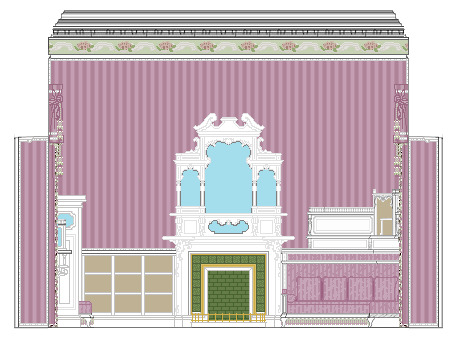







Renderings of the Lilac Cabinet (Mauve Boudoir), and the Palisandre (Rose-wood) Drawing-Room of Her Majesty, Empress Alexandra Feodorovna at the Alexander Palace as it looked before 1941. I started these renderings (with Windows/MS Paint) as the reconstruction project (rehabilitation as well) of the Alexander Palace in Tsarskoe Selo is going on currently. PLEASE if you decide to re-post and/or share these, make sure that you credit me appropriately. I work very hard on my pieces, and these are no different. They took hours of research, fine-tuning colours, and even making colour palettes for each of the rooms. Thank-you! On October 24th, a big unveiling was done of the currently-in-progress reconstruction. The rooms unveiled were the following: 1. The Bedchambre of Their Majesties. 2. The Lilac Cabinet (Mauve Boudoir) of Her Majesty. 3. The Palisandre (Rose-wood) Drawing-Room of Her Majesty. 4. The State Reception-Room of His Majesty. 5. The “Old” Working-Study of His Majesty. 6. The Moorish Bathchambre of His Majesty. Rooms that are in the process of reconstruction (or restoration): 1. The Maple Drawing-Room of Her Majesty. 2. The “New” Study (Front Office) of His Majesty. 3. The Corner Reception-Room of Her Majesty. 4. The Mountain Hall (Parade Enfilade of State-Rooms). 5. The Imperial Library (total of four rooms, two being the Great and Small Libraries). By Spring 2020, GMZ Tsarskoe Selo has said the first eight reconstructed interiors will be opened for the high season (most likely May) of tourism. The entirety of the rehabilitation project for the Alexander Palace will be completed no earlier than 2022. The Alexander Palace is to become a memorial museum to the Imperial Family. Some background information on the Alexander Palace’s saga: 1792-1796: Designed and built for the future Tsar Alexander I, by the Italian architect Giacomo Quarenghi. It is designed essentially as a Summer estate, and not a full palace. 1894-1917: Permanent residence of Tsar Nicholas II, Empress Alexandra and their five children. The Imperial Family began to live at the Alexander Palace on a permanent basis more so in 1905. 1917-1918: (September) autochrome plates are made during the inventory of the Palace complex at Tsarskoe Selo. 1918-1941: The Alexander Palace is kept as a museum “honouring” the Imperial Family. Looting happens from with-in the Palace-museum. Between 1930 and 1941, the NKVD has permission to use the left wing (not the Imperial Wing, which was the right one) as a “holiday” establishment. An orphanage is established in the former rooms of the Imperial Children during this period. In 1941, evacuation of the Palace-museums in and around Saint Petersburg begins. Over 800 pieces of art-work and even furniture are evacuated from the Alexander Palace by the last curator at this time; Anatoly M. Kuchumov. 30,082 Total pieces were in the Alexander Palace in 1941, including 20,000 books from the Imperial Library (and personal collections of the Imperial Family). 1942-1944: The German forces (National Socialist Party, Nazi’s) occupy Tsarskoe Selo and make the Alexander Palace SS headquarters of operations. Along with Spanish allies, they loot and damage the Palace complex of Tsarskoe Selo. Much wooden decoration of the interiors is used as fire-wood. Shelling and artillery fire further damages the interiors. 1944-1946: Inventory of the suburban palace complexes. The Alexander Palace is the least-damage of them, and so all the collections are sent here. The Palace is mothballed, and in 1946, given to the USSR Academy of Sciences to store the collections of the Institute of Russian Literature. 1947-1951: The Alexander Palace begins a lengthy process for a major exhibition on the life of Alexander Pushkin (150th Anniversary, which Tsarskoe Selo has been renamed to). During this period, the remnants that remained of the damaged rooms of the Imperial Family were completely destroyed. Generic, Russian Empire style rooms were installed to preserve the work of Quarenghi. In 1951 the ownership of the Palace-museum is transferred to the Russian Navy. In the same year, what is left of the Alexander Palace’s collection (part of the collection of the evacuated items in the central repository of museum funds of the suburban palace-museums is received at Pavlovsk. October 2009: Ownership of the Alexander Palace is given back to GMZ Tsarskoe Selo. June 2009-2011: The Parade Enfilade, and roof of the Alexander Palace are restored and fixed for the 300th Anniversary of the founding of Tsarskoe Selo. These three State-Rooms original to Quarenghi’s design are unveiled in 2011 to the press and tourists after. 2015: Studio 44, headed by Nikita Yavein was awarded the commission for the project of the reconstruction and rehabilitation of the Alexander Palace. A press release is held in the Alexander Palace detailing the reconstruction, and rehabilitation project. 2015-2019: The Alexander Palace (closed in 2015) has been under a comprehensive reconstruction/rehabilitation project under the auspices of GMZ Tsarskoe Selo and Studio 44, the firm awarded the commission in 2015. Stavros, a furniture design firm in Saint Petersburg has presided over all the wooden decoration; Artcorpus_Interiors has presided over all of the ceramic tiling, and was predominantly responsible for the work on the Moorish Bathchambre of His Majesty. Janusz Matusiak was responsible for all of the reproduction textiles (curtains, furniture upholstery, etc) for the reconstructed interiors. October 24th, 2019: A second press release is held in the Alexander Palace for the unveiling of the current progress of the reconstruction: Eight historical interiors (of which one was still extant from after the Second World War) were unveiled to the press. It is anticipated that the eight reconstructed rooms will be fully opened to the public during the high season of tourism in May most likely. The project itself will be finished no earlier than 2022.
#alexander palace#nicholas ii#empress alexandra feodorovna#giacomo quarenghi#gmz tsarskoe selo#studio 44#stavros_spb#artcorpus_interiors#janusz matusiak#Tsarskoe selo#Russia#reconstruction#rehabilitation#restoration#Александровский дворец#Царское село
12 notes
·
View notes
Text
RAGNAROK
If the 19th century can be characterised by the rise of industrialisation and the 20th century by the expansion of the market economy and globalisation, the defining characteristics of the 21st century are dramatic and pervasive transformations and a shift from unipolarity towards multipolarity.
Triggered by disruptive technological change, the onset of the Fourth Industrial Revolution has led to fundamental changes in the nature and structure of the economy. With significant redistribution of the level, location and composition of output, our organisations are more global and interconnected than ever. A hastening erosion of trust in extant political frameworks and institutions is driving human societies to be more isolated and divergent.
In fact, with the increasingly strong probability of global growth falling short by at least 1 percentage point from projections, the magnitude of the decline is comparable to the agonising global recession of the early 2000s.
By contrast, the economic outlook for South Asia continues to be strong. In the past half-century, emerging and developing economies have significantly enhanced their contribution to global output from around 15% to well above 50%. Underpinned by strong domestic demand, private consumption and investment, a growth projection of 7% suggests South Asia’s resilience and strength to not only weather the global slowdown but also to contribute to propelling global growth forward.
Especially noteworthy is the economic outlook of the region’s largest economy, India. With its GDP growth projected to again increase by 7.5% in the next few years, India continues to be one of the world’s fastest-growing major economies. India’s has been a dramatic rise, deserving of the global attention that it has commanded. The stage is set for India to realise its vision of becoming a $10-trillion economy in the next decade-and-a-half and to assist in appeasing the woes besetting the world economy.
Steered by decisive leadership, India is rising to the occasion through a significantly enlarged global profile. India’s commitment to renewable energy through voluntary and ambitious renewable power capacity targets, a lead role in the Paris Climate Agreement negotiations and the International Solar Alliance shows its aspirations of becoming a leader in environment security and climate change mitigation.
India has also expanded its global stature in space exploration through widely celebrated breakthroughs such as its recent lunar mission and its distinction of becoming the fourth country worldwide to shoot down a low-orbit satellite with a missile. India, too, is more involved in global humanitarian efforts and development initiatives, including infrastructure development in Afghanistan, the International North-South Transport Corridor, the Ashgabat Agreement, the Chabahar port and the India-Myanmar-Thailand highway. The Indian Prime Minister has articulated his strong vision for an India-Africa cooperative interest and India’s deepened participation in coalitions such as the Shanghai Cooperation Organisation, the Asian Infrastructure Investment Bank, the India-Brazil-South Africa Dialogue Forum and the BRICS group demonstrate its growing global influence and appetite for enhanced visibility on a range of global initiatives and multilateral fora.
So while there is no agreed definition of what is a 'superpower', fundamental characteristics that is consistent with all definitions of a superpower is a nation or state that has mastered the seven dimensions of state power: geography, population, economy, resources, military, diplomacy and national identity.
Bharat will replace any one of the three superpowers, either Russia, China or America from the list of top three countries of the world in terms of economy and strength, opined famous politicians.
Task in hand
Given the prospects for growth in the country come up with a detailed plan on how you will make India a superpower.
The 5 prerequisite to make a country a superpower are:
1.Strong political system
- Come up with a way to ensures that the government functions efficiently and works for the betterment of people
- Continue with democracy or come up with a new political system to govern our country
2. Strong financial markets
- Come up with ways to increase FDI in India
- Promote and make the BSE, NSE or a new stock exchange the biggest in the world by market capitalisation.
3. The Defence Force (Army-Airforce-Navy)
- Ways to improve the technological as well as physical power of the army
- Develop a new structure to make the army more effective
4. Population
- Improve the quality of education
- Increase the wage level for individuals
- Increase employment opportunities
- Increase life expectancy
- Methods to reduce overall population to help the economy
5. Upcoming fields
- Ensure growth of the country in the fields expected to boom and grow in the future.
- Target industry's and explain how to integrate them in our country.
Along with this, your deliverables include –
• A phase wise implementation plan.
• A Press Release regarding India’s Mission and Vision.
• A detailed Budget and its allocations.
• Tackling other Superpowers
• Differentiation Strategies
(The world is likely to have a lot of superpowers later, how will you make sure that there is only one: India)
DELIVERABLES
- A report of 15 pages
- A PPT of not less than 7 slides
Deadline
Soft copy submission at 11pm 23/11/2019.
(Remember, this is a very long task, a lot of deliverables are required and expected.
Reduce detail and make effective use of time.
What you find on the internet is what everyone else finds. How you use it to your leverage is what makes you different.
Make sure information being communicated is precise and crisp.)
For any queries, feel free to contact Sankalp
Regards,
Team Best Manager.
1 note
·
View note